While the adoption of body-worn and in-car cameras has become a standard practice among law enforcement, members of the public have also taken their own security measures by installing surveillance and doorbell cameras on private property.
These cameras add a sense of safety and transparency, but they also add a large amount of work for evidence managers, investigators, and analysts.
The accumulation of internal video footage, as well as evidence from external sources, has led to a need to process and analyze video quickly.1 Unfortunately, many agencies do not have the necessary resources to dedicate hours to editing and analyzing video, images, and audio files. Many forensic technology companies, however, have set out to provide end-to-end solutions to the editing and analysis needs of the profession.
Editing and Enhancing
“Gone are the days of analog video, but the increase in [high-definition] and 4K video hasn’t increased the clarity of details,” said U.S. Operations Director Blake Sawyer of Amped Software (Amped).2 What has increased is the need for tools to edit or enhance details for investigative purposes.
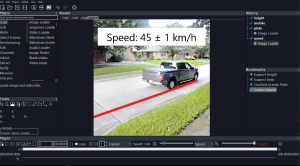
Amped FIVE is designed to make the most of every type of image and video evidence. Short for Forensic Image and Video Enhancement, FIVE allows the entire process—from conversion to analysis to enhancement to presentation—to be completed using one tool, with advanced and customizable processes for conversion, restoration, enhancement, reporting, and more. The goal is to save time and training resources while also providing more accurate results.
With help from Amped Engine, an integrated CCTV/DVR conversion tool, FIVE ensures that every video plays back accurately. Over 140 filters allow officers to clarify objects such as faces and license plates to obtain the best information from video. The enhancement filters even allow the user to estimate the height of subjects or the speed of objects.
The system automatically documents every step a user takes to maintain transparency throughout the investigation, replacing written reports. When it is time to submit evidence to court, FIVE generates a report with selected images and reference materials that prove every step is backed by a trusted algorithm. “FIVE’s presentation tools enable the public and the justice system to see what might otherwise be hard to see easily, and the generated report ensures that every step can be trusted and repeated,” said Sawyer.
MotionDSP, a product line of Cubic Digital Intelligence, also places an emphasis on video enhancement, but it seamlessly integrates redaction capabilities into their flagship product to obscure personal identifiable information (PII) for public release and courtroom presentations.
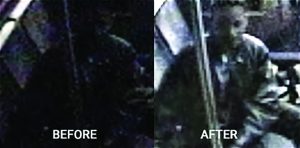
Forensic Studio accepts digital evidence from various sources, including body-worn cameras, CCTV, and cellphones. The patented algorithms included in Forensic Studio analyze multiple neighboring frames, selecting the best pixels to reconstruct a high-resolution version of the raw footage.
Showcasing the company’s ongoing commitment to innovation, MotionDSP leverages their partnership with NVIDIA to improve the quality of real-time video. The real-time video enhancement feature enables overlay functionalities, which identifies street names, addresses, and other critical information for airborne situational awareness.
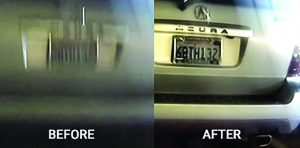
By employing advanced image processing algorithms, forensic tools like MotionDSP’s Forensic Studio ensure that users prepare clear and forensically valid video evidence for courtroom presentations. This can also contribute to the credibility of the agency.3
“There’s a lot of overhead in trying to locate all those different faces that are fundamentally PII,” said Rohan Galloway-Dawkins, chief product officer at Versaterm.4 Versaterm offers an automated redaction capability through Visual Labs. The software-based ecosystem guides users through the incident response to the incarceration phase.
Visual Labs is an application that runs on any Android device and serves as a body-worn or in-car video camera. Once the footage is uploaded to the cloud, the editing process can begin—in the field or at the office. When it comes to the utilization of digital evidence in court or sharing the content publicly, certain privacy protections must be met. This is why Visual Labs is integrated with facial recognition technology. The software will go through each frame and image to find every face and auto-redact those that are keyed to be private.
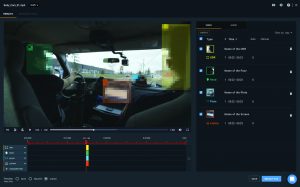
With a similar automated approach to redaction, Veritone relies on artificial intelligence. Built on the company’s larger platform, aiWARE, Veritone Redact automatically detects heads, mobile data terminals, and license plates within video evidence. A unique feature of Veritone Redact is that, as a user listens to audio, the software will transcribe the track. The user can type keywords into the search function and results will appear highlighted in the transcript. If these keywords need to be omitted from the audio track, Veritone Redact offers that capability.5
Although the technology performs the heavy lifting, the officers have the final review of the content, and the redacted video or audio can be modified if any PII was missed.
Analysis
Video and photo analysis play an increasingly important role in investigations. With the proliferation of available evidence, it is nearly impossible to comb through it all quickly and accurately. There are, however, sophisticated analysis tools that have improved the efficiency and accuracy of law enforcement investigations.
Digital evidence has come a long way over the last few decades, and almost every case in modern society includes some sort of video, photo, or audio file. “There is a much deeper understanding of how digital video works and how, with proper interpretation, it can be used for more than simply observation,” said Sawyer.6
Veritone gained their understanding through the media and entertainment realm. Because video and audio are the primary assets of that space, having previous knowledge of and experience with this technology dramatically influenced the solutions built to solve the problems of public safety professionals. As camera technology advanced, the workflows within police agencies remained the same and were not built for the upsurge in digital evidence. “Video and audio have become such a key part of our culture,” said Jon Gacek, senior vice president and general manager of Veritone Public Sector.7 “We need to equip agencies to be able to manage it and not waste time on things they do not need to spend time on.”
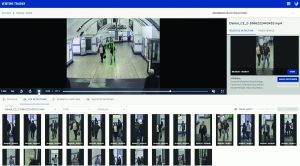
Menial digital evidence analysis tasks are diminished by Veritone Evidence. Originally used to manage video, audio, and documents in the media and entertainment profession, Veritone Evidence was reskinned and modified to be useful for managing public safety workloads. The cloud-based software helps agencies to quickly access, search, manage, and share their digital evidence. As the evidence is being ingested, the artificial intelligence within Veritone Evidence will instantaneously tag unstructured forensic evidence with metadata, allowing faster and more accurate keyword searches.
Acting as a hub to all digital files, a user can easily switch from Veritone Evidence to Veritone Redact and other applications to transcribe and translate audio, redact PII, and track persons of interest across files.
Although it is a body-worn camera at its base, Versaterm’s Visual Labs also acts as a digital evidence management system. Within the analysis side of the platform, there is historical and live visibility to the location of officers and location of where the recordings were generated. Supervisors are able to see where their officers are patrolling and where their resources need to be leveraged most. From there, supervisors are able to look at analytics of the recording locations in respect to the incidents that are being investigated.
The Visual Labs application is still available even if there is no connectivity on the officer’s mobile Android device.
“Having tools that can help find evidence that is pertinent to the investigation saves a lot of time and also leads to more just outcomes,” said Galloway-Dawkins.8 With video editing and analysis tools, an agency can take some of the workload away from their officers so that they are able to focus on keeping their communities safe.d
Notes:
1Dani Thach, Amber Riley, and Niosha Kayhani (product team, Cubic Digital Intelligence), email interview, November 30, 2023.
2Blake Sawyer (U.S. operations director, Amped Software), email interview, December 1, 2023.
3Dani Thach, Amber Riley, and Niosha Kayhani, email interview.
4Rohan Galloway-Dawkins (chief product officer, Versaterm), phone interview, November 21, 2023.
5Jon Gacek (senior vice president/general manager of the public sector, Veritone), phone interview, November 30, 2023.
6Sawyer, email interview.
7Gacek, phone interview.
8Galloway-Dawkins, phone interview.
Source ListPlease click on the companies’ names to go to the companies’ websites. |
|
|
|
|
Please cite as
“Reducing the Video Workload,” Product Feature, Police Chief 91, no. 1 (January 2024): 70–72.


